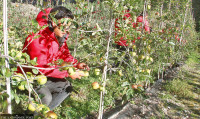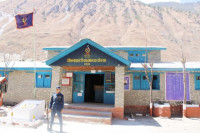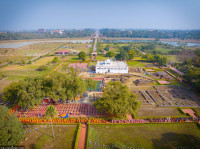National
Nepal’s jute industry survives on imports
Production collapse puts the golden era of the country’s jute farming at risk of fading into history.
Parbat Portel
Jute was once the dominant cash crop of eastern Tarai. Fields of tall, golden stalks once stretched across Morang, Sunsari, and Jhapa, feeding dozens of factories and powering the region’s economy.
Today, the picture is starkly different. Production has collapsed, cultivation is vanishing, and Nepal’s jute industry survives on imported raw materials from India and Bangladesh.
The reversal is striking. In the past, raw jute from Nepal’s eastern plains was exported to India. But now, nearly three quarters of the raw jute consumed by Biratnagar’s mills must be brought in from across the border.
“We import raw jute worth about Rs3 billion annually and re-export finished products worth more than Rs7 billion, mostly back to India,” said industrialist Raj Kumar Golchha.
Only half a dozen private jute factories remain operational around Biratnagar, down from more than a dozen just a few years ago. Together they require about 65,000 tonnes of raw jute each year.
Local farms supply just 25 percent of that demand; the rest is met through imports.
In September 1970, the Nepal government and the Asian Development Bank agreed to launch a jute development programme in Nepal. With the establishment of the Nepal Jute Development Board, the programme started in an organised way.
The Jute Development and Trading Corporation replaced this board in October 1974.
There were several jute mills in the private sector, mainly in the eastern region.
In terms of production, it had been the largest cash crop in Nepal. In the earning of convertible foreign exchange, jute and jute products contributed nearly 50 percent in 1979.
The exported amount of jute and jute products in 1978-79 was Rs296 million, making it the nation's leading earner of foreign exchange.
The jute decline began after the corporation closed in the mid-1980s. Until then, farmers had access to subsidies for seeds and fertiliser, as well as training and technical support.
Without institutional backing, many abandoned the labour-intensive crop. Farmers cite the lack of retting ponds, rising labour shortages, poor market prices, and high production costs as reasons for quitting.
Three decades ago, more than 70,000 hectares in Morang, Sunsari and Jhapa were planted with jute, yielding over 100,000 tonnes annually. Now, according to the Agriculture Directorate in Biratnagar, cultivation has shrunk to just under 7,000 hectares, producing around 10,000 tonnes a year.
The crop’s fortunes are intertwined with the history of Biratnagar’s industrial rise.
In 1936, Ram Lal Golchha, a young trader from Bengal who had settled in Morang, partnered with Indian associates to establish Biratnagar Jute Mill—the first industry in Nepal. The factory’s success ushered in a golden era of commercial jute farming in the Tarai.
More mills followed, including Raghupati Jute Mill, fuelling prosperity in the region.
Today, the government-owned Biratnagar Jute Mill has long been shuttered, though private ventures such as Raghupati, Arihant and Baba continue to run.
On the farms, the decline is palpable.
Mohammad Sajid, a farmer in Sunsari’s Bhokraha Narsingh Rural Municipality, once planted jute on more than 10 bighas of land. Today, he cultivates only three bighas. “It may shrink even further next year,” he said.
Dozens of farmers along the Inaruwa–Koshi Barrage road can be seen uprooting stalks, soaking them in muddy ponds for two weeks to extract the fibre.
Locals use the leftover stalks as firewood and fencing material. But as acreage dwindles, their future is clouded with uncertainty.
The numbers underline the shift.
Customs data show that in 2024-25, Nepal imported raw jute worth more than Rs818 million through the Biratnagar checkpoint alone. That year, jute yarn worth Rs334 million and jute fabric worth over Rs6 billion were exported, mainly to India.
The Mechi Customs Office in Kakarbhitta also reports a sharp rise in imports, primarily from Bangladesh.
In 2024-25, jute and jute products worth Rs4.45 billion entered Nepal through Mechi, making it the second-largest import commodity at that checkpoint.
Imports had risen by 28.4 percent compared to the previous year.
“Most of the supply comes from Bangladesh, with Indian jute making up only a small share,” said customs officer Ishwar Kumar Humagain.
As imports grow and domestic fields shrink, Nepal’s once-thriving jute economy risks becoming little more than a memory.
Farmers face falling profits and mounting pressures, while factories remain locked in a cycle of dependence on foreign raw materials.
For an industry that once symbolised Biratnagar's rise as Nepal’s industrial capital, its golden past is fading fast.




 6.1°C Kathmandu
6.1°C Kathmandu










%20(1).jpg&w=300&height=200)




